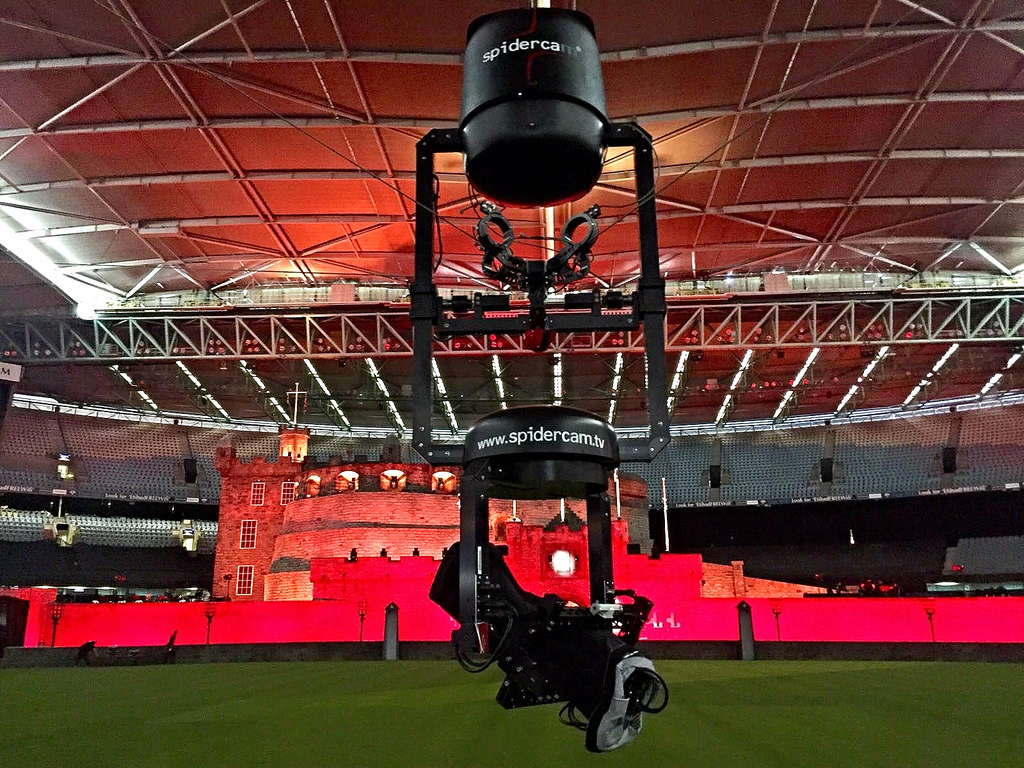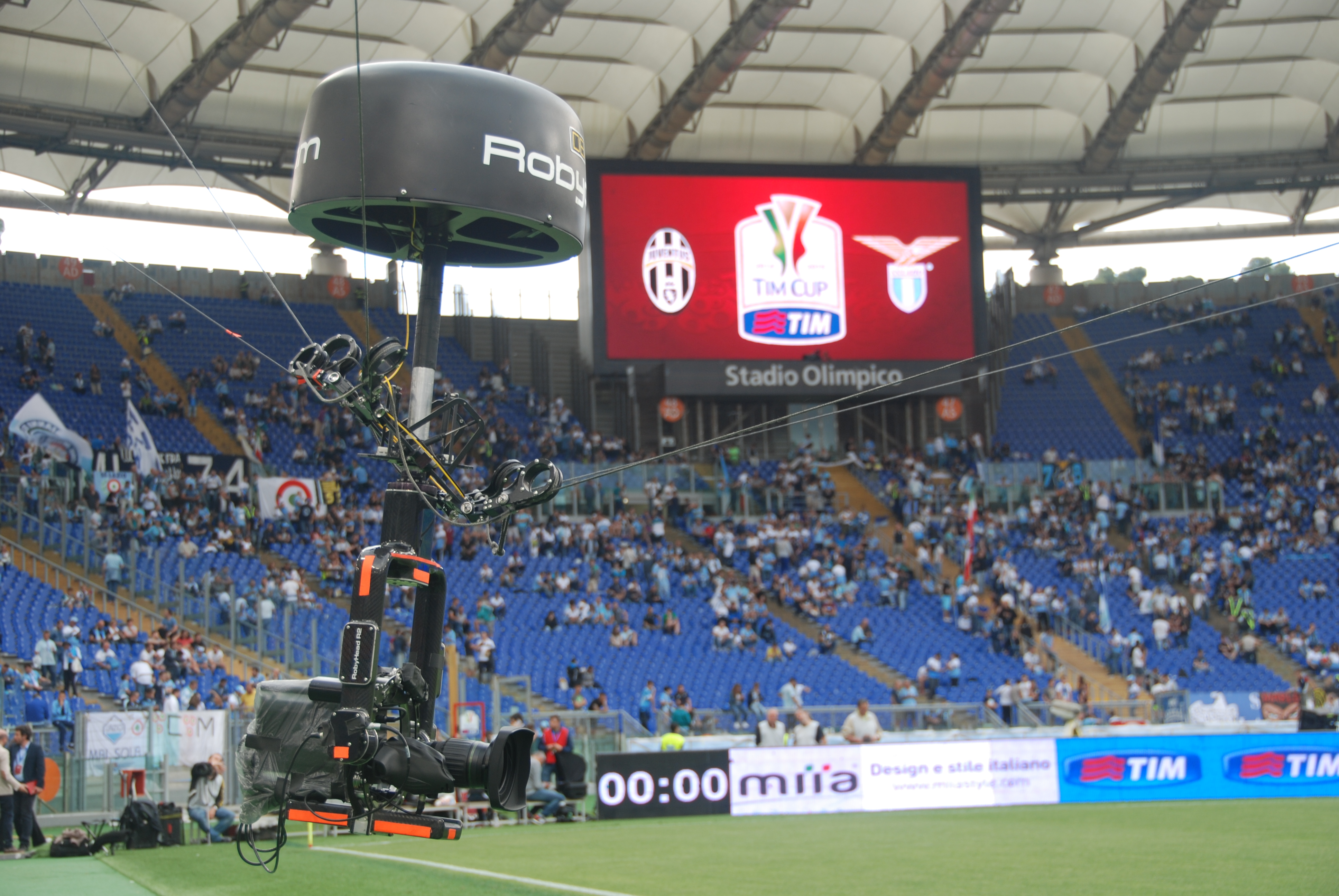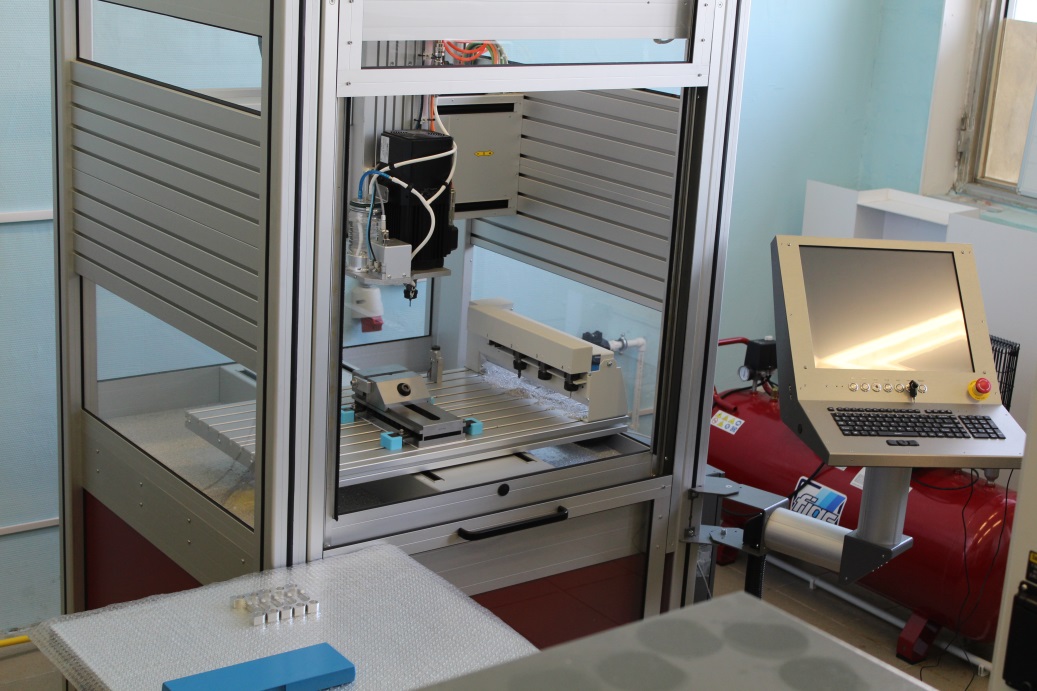What kind of spider robots fly over the stadiums and shoot football. Interview with the creator of Robycam
Hundreds of tons of equipment was brought to the World Cup in Russia. Each stadium has 34 state-of-the-art cameras installed that broadcast the image in HD, UHD and 4K HDR. Previously, they were placed only at the edges of the field, but since 2014, cameras at the world championships have been flying right over the heads of athletes.
You, probably, saw these gizmos, similar to the pumped quadcopter with a shell. In fact, this suspended robot platforms on the ropes.

Photo: Movicom
They are arranged like this:

There are not so many companies in the world that produce them. The tender for participation in the World Cup 2018 won the Austrian company Spidercam. She has been making similar systems since the beginning of the 2000s and has long been a leader. Championship 2014, the Olympics in Rio and dozens of other events - everywhere were her robots.
Spidercam has a competitor from Russia - Moscow company Movicom. She developed the Robycam harness system and is now also fighting for the global market.
“We have already won a lot of projects from them in the world, but at the time of the tender two years ago, unfortunately, it did not work out, although we were involved,” writes Viktor Pakhomov, CEO of Movicom.
We got in touch with each other, and Victor spoke in detail about the cable systems: how difficult it is to manage them, how the pilots take exams, why they need a base with their fingerprints; how much these things cost, whether they are dangerous; what are the subtleties and features of the global TV market, and what difficulties await a company from Russia there.
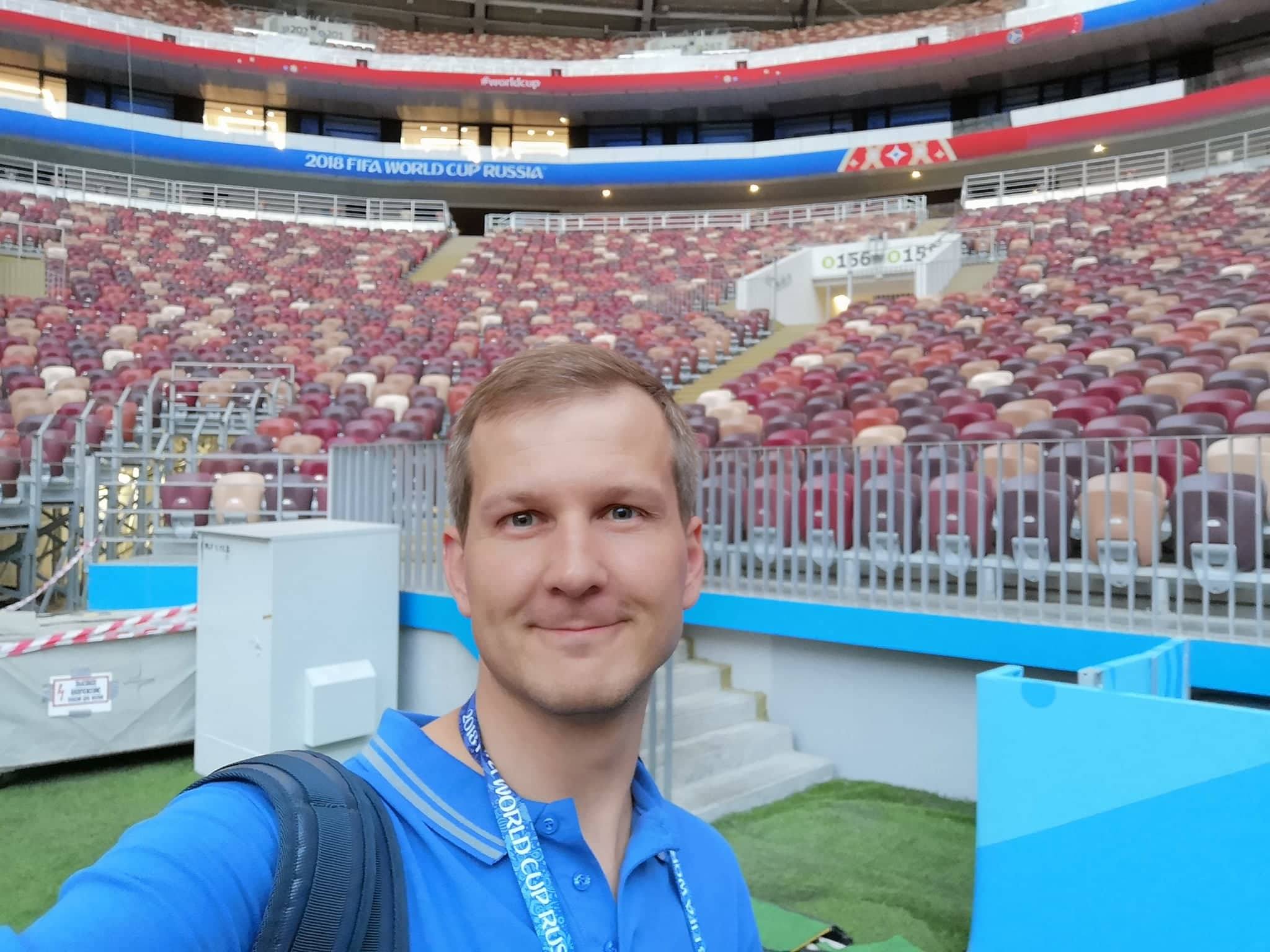
Victor, how did it all start?
Oh, it's a long story. At MSU there was a very strong school of robotics under the leadership of Anatoly Viktorovich Lensky - one of the leading in the world. He was our teacher, and we lived in this school, made robots, engaged in mechanics, electronics. But the school is a school, we grew up little by little, and the people who taught us quietly grew old. Anatoly Viktorovich is no longer, unfortunately.
At some point, Oganes and I, my friend and partner, had the idea that we should continue all this. At first we had naive, romantic notions that everyone needed robots, technologies around were in great demand.
At first we were engaged in technical competitions. Participated, for example, in the world championship in robot football. Then they created modules for different robotized complexes. We didn’t have any specific customer - either one project or another. We had a good platform, and it was in demand everywhere. This is where the company came from.
This is how the robot football competitions take place. But more about the robots themselves
And how did you come to the shooting robots?
At some point, people from the cinema turned to us, asked to make a remote truck control system for the movie “street racers”. On the set, they wanted to dump the car into the river. This is a dangerous trick, so he was afraid to perform with a stuntman.
Robots are after all a universal history, a multidisciplinary thing. Our modules and there approached. So began the work with the movie. We made, for example, the motion control system for the movie “What Men Talk About,” which was used for filming in the car.
Then we were introduced to Sergei Valentinovich Astakhov in St. Petersburg, and he initiated the creation of the Robycam. This became the most famous project with us, of course.
We agreed with Garrett Brown and asked for his permission. On the one hand, the issue of the patent, on the other hand - just ethics. We in the Moscow State University was so instituted that we need to ask. But everything went well, he reacted quite positively. The system turned out, it worked very well.
Do I understand correctly that you started doing Robycam for the Sochi Olympics?
We have done it before. But they were looking for partners who would use it and somehow develop it in the world. And there was a project in Sochi. The task was to create a big strong production TV team in Russia. For Sochi, for government events, for the Universiade in Kazan.
At first we received an order for one system. But few people understood special cameras. After all, there are standard cameras: television machines arrive, put on a tripod and work. And there are cameras that need to move, or something special in them, super slow, for example - this is all called Special cameras. This sector is quite new in television. He was probably 10 years old, and before that there was no concept of a “special camera”.
I was offered: "Let you build this unit and lead it." And for four years I have been building a team that would use all this. Our company (Movicom) was as a technology partner. It was assumed that after Sochi we would be actively working commercially all over the world. But it happened a little differently.
The company decided to concentrate on Russian production. And then there was a division team. People who are more focused on public service, in the end remained on the Russian channels. And people focused on international television joined us, and we began to engage in the services themselves.
The characteristics of the Spidercam indicated that it accelerates to 9 meters per second. You, I saw, indicated 10.
Yes, we generally have winches up to 15 meters per second. It's just that it's pretty dangerous and scary at all when the speeds are great. 10 is a logical software constraint, not a physical one. But in general, the camera moves usually 8 meters per second. 10 meters is on the run, and more honestly not needed. Running, one hundred meters, in the biathlon at the finish, that's where you have to keep up.
Anyway, all these systems rest against the combination of the moved weight, dimensions, covered space and power of the winches - and their cost and size are determined accordingly.
I think we have a little bit better in this sense than Spidercam, because we have three-axis heads, which are made of carbon fiber and carbon fiber. Therefore, we have a moving mass is easier than theirs. If there is 25 kg without a camera, we have it somewhere 16-18. Accordingly, we can use more compact winches.
And what kind of camera can stand the head?
There is a standard system that is used in television, a set of box cameras. All cameras that exist - 4K, broadcast - we support. A camera with a lens weighs 4-5 kilograms.
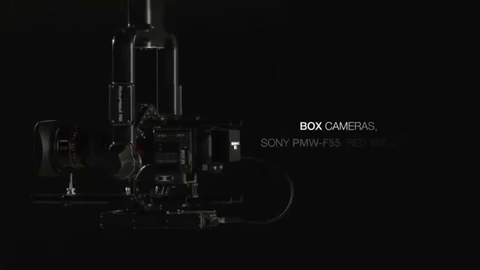
I read an interview with a technician. It seems that he said that it takes almost two years to learn how to manage such a thing. Is it really that hard?
Depends on a person. If he was already working as an operator on a crane or with a controlled head, he could work here. If we talk about the pilot or, especially, the installation supervisor - and he usually works as a pilot, and is responsible for the entire installation, configuration, trajectories, and safety zones - this is much more difficult.
Specifically, Robycam has system certification and training. It is not very big, around two weeks. Theoretical and practical part, after the exam plus control from our side in the first few shootings. If a person gives, then receives a certificate. Then his fingerprints fall into our base, and he can work on any such system in the world. For example, from another company that bought a system from us, from our partners in Japan, in China, in Germany.
There are, of course, people who for two years do not receive a certificate. They just don't pass the exam. Now one person received the status two years later.
And how is this exam?
You need to install the system from scratch. A man is given a stadium: “here you are, put it on. Here people will help you, and you lead the process. ” Then he must dismantle everything and install it again. That is, all done twice.
In the process, they can intentionally break something and see how it will react. Understands or does not understand what to do. I would not say that for a technically educated person this is some kind of super science. This is more about attentiveness and attitude.
Is it difficult to install the system at all?
Not very, but rather laborious. You need to plan everything, map the heights. At least it takes three hours. Maximum - two or three days, if it is a very difficult story.
We worked at the Paralympic Games ceremony at the Fishta in Sochi. There were a lot of decorations hanging. And the zone where you need to work was inside, in the midst of it all. The winches were far away, the system unit had to be carried out in this zone, because the cables could not be started directly. There, of course, it took a long time. Climbing work.
How much is the average stadium put on?
For the day, for the shift. Sometimes it is done in the morning if the match is in the evening, but rarely. Depends on the stadium.
How many people are involved?
Standard composition - three or four people.
Promovideo Robycam with shots of installation, filming and management.
What usually causes problems for people who cannot master it for two years?
Well, all countries have their own specifics, their cultural characteristics. In Japan, for example, a special order. They are not accustomed to the fact that one person in himself accumulates knowledge about a large number of details. In their team, each makes its own separate part, so there is its own character.
In China, difficult. They are wayward, not ready to dive deep into problems.
And with the installation and management everything is difficult?
No, getting a pilot's license is easier. His access level is much less.
Of course, this is a dangerous thing, it flies over people, it is a robot. Considering that this is still in the creative field - that is, it is not a specific object where it was placed and it is automatically controlled. No, it moves here like this, then syk. That director asked, something else - everything is serious.
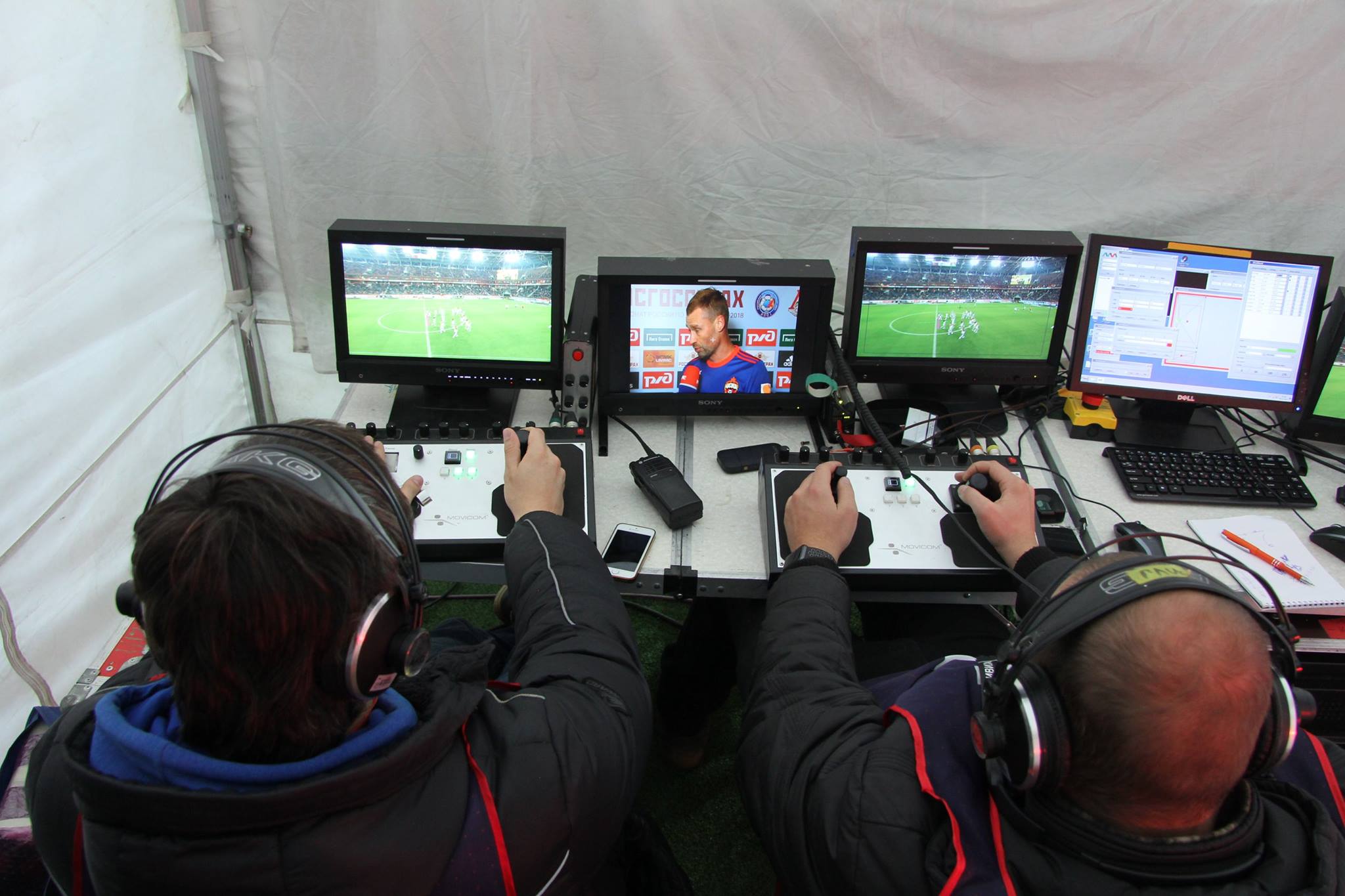
Bases, fingerprints, and were introduced, because even at the very beginning of the journey in one of the countries, we understood that people are dishonest, without understanding.
We have full logs of what is happening. And when we were told that “everything broke here”, we looked and ... we say: “What are you guys ?! You yourself create total lawlessness. ”
Where was it?
In Central Asia. And then we introduced fingerprints. The person who authorizes the work must be in the database, and he is responsible for following the rules. And the rules are synchronized with international standards for ensuring the security of such systems. We must follow them. And if we break somewhere, we will lose this certificate.
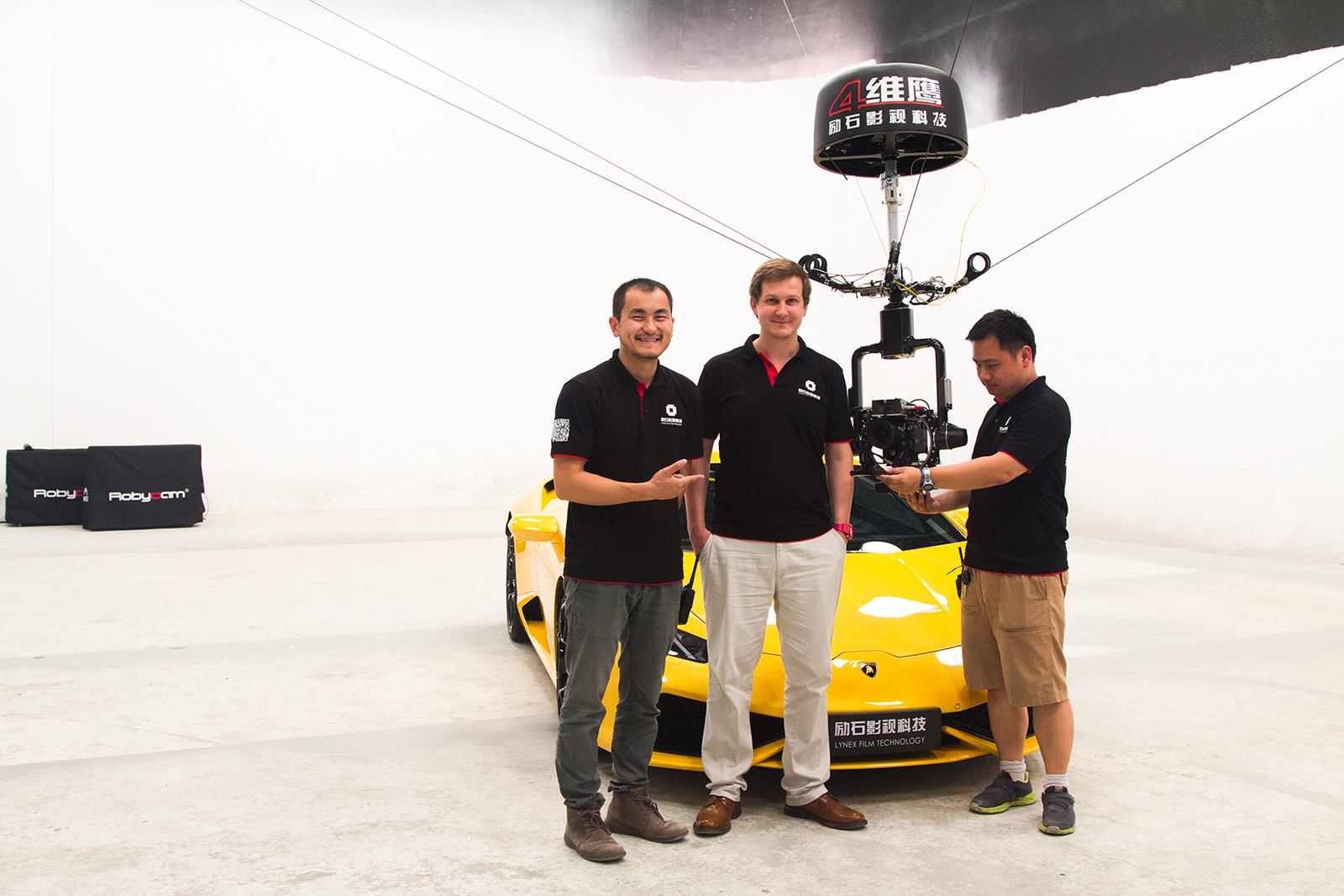
I read Spidercam had some nasty cases. At the Olympics, the camera fell, someone knocked the ball. Did you have something like that?
At the Olympics fell not Spidercam. They even had to make excuses and release a refutation. After all, they all immediately wrote news that Spidercam fell, but in fact the system of a completely different type and another manufacturer fell - the cable car. And frankly, this is a muddy story. It is believed that it was sabotage. As far as I know, someone damaged the cable-carrying system, which is why the fall occurred.
There was a case with Skycam when he fell during the NFL match. They rehabilitated for a very long time, but they succeeded. Corrected, replaced all systems. Probably it was the loudest case. Well, it happens, the ball will fall, yes.
And How?
We have no loud cases of pah-pah-pah. As a rule, most of the work takes place under automatic control conditions. The system does not fly to where someone is.
But you can't work like this all the time. Sometimes you need interesting shots. On football, there are moments when you have to show the field as low as possible, foreground. The operator disables the restricted area, takes responsibility and works in a purely manual mode, where its automatic does not save. And maybe ... creatively play around - accidentally touch someone, hit or something else. But there were no accidents.
How is security tested?
All mechanical components are calculated and tested. Some are tested at the factory, some we test at home.
Mostly safety comes from excess safety. The German standard says that cables should have a margin of 12 times the maximum load that can occur. This is a huge stock, one of the largest ones that can be found.
The control system is duplicated, in general everything is duplicated. On any control element there is a second one that is only concerned with observation and has the ability to stop work if something happens. Like on a plane.
Duplication or triplication in probability significantly reduces the risk than reinforcing any cable even several times.
When you receive an order, does the system have to be made for each specific case or do you sell a standard model?
We have two divisions. Sale of products and services. Services - we ourselves remove it with the help of our complexes. If this is a product, then there is a standard line with prices. If people buy themselves to use at various events, then, as a rule, they take a standard one. If this is a stadium, then it is more often a piece project. Our system stands at Sergei Galitsky in Krasnodar, in Uzbekistan there are two systems.
But this is rather our decision, the client is not so important. We leave the system at the facility and it is easier for us to close it, build it into the roof, so we do it on purpose. We think how for each stadium to do better, more compact.
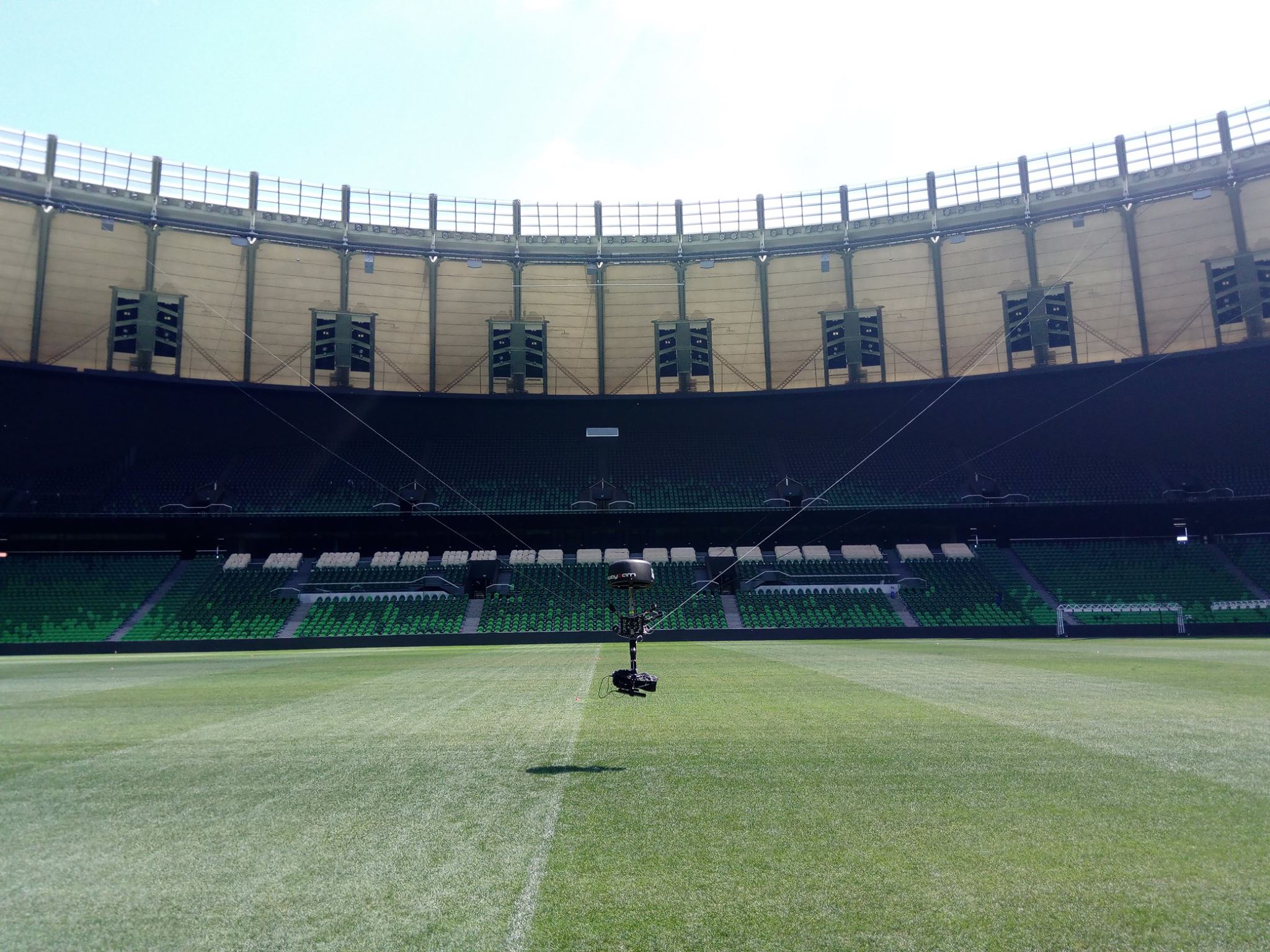
Spidercam doesn't do that. They have one rolling system, and they sell it to the stadiums. And then there people take out the winches on the field, put them near the field, the cables go up and everything is working.
We are somehow afraid to do so, even though it is easier and more profitable. It is terrible why - if you wish, you can throw a fire piece into this cable. Although not flammable, it is still dangerous. We prefer to hide as much as possible. In addition, it does not interfere, does not loom before your eyes.
And how much does such a system cost?
In the region of 400 thousand euros. 300-400 full system costs.
More often rented or bought?
For rent. For most, this is complex equipment that needs servicing; you need to have a supervisor. And people fear not because they have not enough money, but because they need to support the team, be responsible for it. The telescope also costs a lot of money, 300 thousand will be allowed there. But telescopes are bought much more, because with them is easier. And with this kind of system is difficult. They are bought either by rental companies, or objects, stadiums.
Where is your production?
In Russia - in Moscow and in Kaluga. In Moscow, we have an industrial technopark, so there is a room that allows you to collect. Final assembly more often in Moscow.
It is interesting to know how is the tender for such events? World Cup, for example.
Oh, this is a difficult topic. I have no right to disclose. Very few companies have to do with this, such a closed story. We have long gone to international events. Not so easy to get to work there.
I just read about Spidercam, I listen to you, and it seems that your system is better. What do you think?
Everyone has advantages. But we are from Russia, and Spidercam from Germany. Russia has a very weak lobby in the television business. In general, in the technological sphere - besides IT - Russia has very weak positions. In TV, connections play a strong role.
Well, that's partly why we are not working now? At the World Championships, in my opinion, 8 or 6 creative teams, they move between cities. There are no Russians at all. The main teams are the Germans, the British, the French. These people are constantly working together, for example, in the Bundesliga, and they do not want to change, even if there is something better.
Augmented Reality on Robycam Systems
But its people. It takes a very long time to change the situation. We are trying to create our presence in the world. Opened an Italian company, it is actively working. Thanks to this, we manage to get something. If the company is Russian - these are real difficulties. Now, unfortunately, no one will be particularly pleased with the Russian company.
No one in the world has complete superiority. If someone says this, then this, of course, raises doubts.
It is necessary to make decisions compromise, choose. As in a role-playing game - overall can be higher and higher, but something will still be worse than that of another player.
The scheme they came up with has advantages and disadvantages. They do not have three-axis stabilization, they do not rotate around the axis of the camera. This does not allow, for example, in a good wind to give the horizon, the camera sways. It does not allow to creatively present a picture, and at some events it is necessary.
But on the other hand, this scheme allows them to make the greatest coverage, the largest usable space at given points. Their work area is the most extensive in relation to any system in the world.
This is their dilemma. To move on, they need to change the concept. I don't want to change it, and I understand them very well. I wonder what they decide.
Of course they have advantages, it is 100%. But we have. No one has complete domination.
What events will compete in the near future?
Of course, the Olympics, the European Football Championship, and football championships from different countries, the World Championships in various sports. We will continue to work.
You, probably, saw these gizmos, similar to the pumped quadcopter with a shell. In fact, this suspended robot platforms on the ropes.

Photo: Movicom
They are arranged like this:

At the corners of the stadium are placed winches with cables attached to them. The robotized head is suspended on these cables. With the help of electric drives, it can move in all directions, both in horizontal and vertical planes. At the control station, the system is controlled by two people - the camera operator and the pilot of the robotic head. The whole system is connected by fiber. The head is powered by batteries, which charge enough for up to 8 hours.
There are not so many companies in the world that produce them. The tender for participation in the World Cup 2018 won the Austrian company Spidercam. She has been making similar systems since the beginning of the 2000s and has long been a leader. Championship 2014, the Olympics in Rio and dozens of other events - everywhere were her robots.
Spidercam has a competitor from Russia - Moscow company Movicom. She developed the Robycam harness system and is now also fighting for the global market.
“We have already won a lot of projects from them in the world, but at the time of the tender two years ago, unfortunately, it did not work out, although we were involved,” writes Viktor Pakhomov, CEO of Movicom.
We got in touch with each other, and Victor spoke in detail about the cable systems: how difficult it is to manage them, how the pilots take exams, why they need a base with their fingerprints; how much these things cost, whether they are dangerous; what are the subtleties and features of the global TV market, and what difficulties await a company from Russia there.

Victor, how did it all start?
Oh, it's a long story. At MSU there was a very strong school of robotics under the leadership of Anatoly Viktorovich Lensky - one of the leading in the world. He was our teacher, and we lived in this school, made robots, engaged in mechanics, electronics. But the school is a school, we grew up little by little, and the people who taught us quietly grew old. Anatoly Viktorovich is no longer, unfortunately.
At some point, Oganes and I, my friend and partner, had the idea that we should continue all this. At first we had naive, romantic notions that everyone needed robots, technologies around were in great demand.
At first we were engaged in technical competitions. Participated, for example, in the world championship in robot football. Then they created modules for different robotized complexes. We didn’t have any specific customer - either one project or another. We had a good platform, and it was in demand everywhere. This is where the company came from.
This is how the robot football competitions take place. But more about the robots themselves
And how did you come to the shooting robots?
At some point, people from the cinema turned to us, asked to make a remote truck control system for the movie “street racers”. On the set, they wanted to dump the car into the river. This is a dangerous trick, so he was afraid to perform with a stuntman.
Robots are after all a universal history, a multidisciplinary thing. Our modules and there approached. So began the work with the movie. We made, for example, the motion control system for the movie “What Men Talk About,” which was used for filming in the car.
Then we were introduced to Sergei Valentinovich Astakhov in St. Petersburg, and he initiated the creation of the Robycam. This became the most famous project with us, of course.
We agreed with Garrett Brown and asked for his permission. On the one hand, the issue of the patent, on the other hand - just ethics. We in the Moscow State University was so instituted that we need to ask. But everything went well, he reacted quite positively. The system turned out, it worked very well.
Do I understand correctly that you started doing Robycam for the Sochi Olympics?
We have done it before. But they were looking for partners who would use it and somehow develop it in the world. And there was a project in Sochi. The task was to create a big strong production TV team in Russia. For Sochi, for government events, for the Universiade in Kazan.
At first we received an order for one system. But few people understood special cameras. After all, there are standard cameras: television machines arrive, put on a tripod and work. And there are cameras that need to move, or something special in them, super slow, for example - this is all called Special cameras. This sector is quite new in television. He was probably 10 years old, and before that there was no concept of a “special camera”.
I was offered: "Let you build this unit and lead it." And for four years I have been building a team that would use all this. Our company (Movicom) was as a technology partner. It was assumed that after Sochi we would be actively working commercially all over the world. But it happened a little differently.
The company decided to concentrate on Russian production. And then there was a division team. People who are more focused on public service, in the end remained on the Russian channels. And people focused on international television joined us, and we began to engage in the services themselves.
Characteristics of cable systems
Spidercam uses the SC250 Field model in stadiums
- Working area 250 to 250 meters.
- Maximum head speed 9 m / s.
- Four winches 148x88x87cm, weight 315 kg. Power requirements: 400-480V, 30-32A, 50 / 60Hz, three-phase power supply.
- Cables 350 meters, withstand 12 kilonewtons.
- Head with gyrostabilization, 160x58x58cm, weight about 30 kg with the camera. Angles of inclination +90 -100 degrees.
Movicom uses Robycam 3D in stadiums
- Working area 200 by 200 meters
- Maximum head speed 10 m / s
- Winches 203х57х90, weight 240 kg. Power is 3-7,5 kW, 3 phases 380-440 Century.
- Cables 330 meters, withstand 12 kilonewtons
- Head with three-axis gyrostabilization, weight about 20kg with camera, unlimited rotation along the axis of the panorama, support for AR
The characteristics of the Spidercam indicated that it accelerates to 9 meters per second. You, I saw, indicated 10.
Yes, we generally have winches up to 15 meters per second. It's just that it's pretty dangerous and scary at all when the speeds are great. 10 is a logical software constraint, not a physical one. But in general, the camera moves usually 8 meters per second. 10 meters is on the run, and more honestly not needed. Running, one hundred meters, in the biathlon at the finish, that's where you have to keep up.
Anyway, all these systems rest against the combination of the moved weight, dimensions, covered space and power of the winches - and their cost and size are determined accordingly.
I think we have a little bit better in this sense than Spidercam, because we have three-axis heads, which are made of carbon fiber and carbon fiber. Therefore, we have a moving mass is easier than theirs. If there is 25 kg without a camera, we have it somewhere 16-18. Accordingly, we can use more compact winches.
And what kind of camera can stand the head?
There is a standard system that is used in television, a set of box cameras. All cameras that exist - 4K, broadcast - we support. A camera with a lens weighs 4-5 kilograms.

I read an interview with a technician. It seems that he said that it takes almost two years to learn how to manage such a thing. Is it really that hard?
Depends on a person. If he was already working as an operator on a crane or with a controlled head, he could work here. If we talk about the pilot or, especially, the installation supervisor - and he usually works as a pilot, and is responsible for the entire installation, configuration, trajectories, and safety zones - this is much more difficult.
Specifically, Robycam has system certification and training. It is not very big, around two weeks. Theoretical and practical part, after the exam plus control from our side in the first few shootings. If a person gives, then receives a certificate. Then his fingerprints fall into our base, and he can work on any such system in the world. For example, from another company that bought a system from us, from our partners in Japan, in China, in Germany.
There are, of course, people who for two years do not receive a certificate. They just don't pass the exam. Now one person received the status two years later.
And how is this exam?
You need to install the system from scratch. A man is given a stadium: “here you are, put it on. Here people will help you, and you lead the process. ” Then he must dismantle everything and install it again. That is, all done twice.
In the process, they can intentionally break something and see how it will react. Understands or does not understand what to do. I would not say that for a technically educated person this is some kind of super science. This is more about attentiveness and attitude.
Is it difficult to install the system at all?
Not very, but rather laborious. You need to plan everything, map the heights. At least it takes three hours. Maximum - two or three days, if it is a very difficult story.
We worked at the Paralympic Games ceremony at the Fishta in Sochi. There were a lot of decorations hanging. And the zone where you need to work was inside, in the midst of it all. The winches were far away, the system unit had to be carried out in this zone, because the cables could not be started directly. There, of course, it took a long time. Climbing work.
How much is the average stadium put on?
For the day, for the shift. Sometimes it is done in the morning if the match is in the evening, but rarely. Depends on the stadium.
How many people are involved?
Standard composition - three or four people.
Promovideo Robycam with shots of installation, filming and management.
What usually causes problems for people who cannot master it for two years?
Well, all countries have their own specifics, their cultural characteristics. In Japan, for example, a special order. They are not accustomed to the fact that one person in himself accumulates knowledge about a large number of details. In their team, each makes its own separate part, so there is its own character.
In China, difficult. They are wayward, not ready to dive deep into problems.
And with the installation and management everything is difficult?
No, getting a pilot's license is easier. His access level is much less.
Of course, this is a dangerous thing, it flies over people, it is a robot. Considering that this is still in the creative field - that is, it is not a specific object where it was placed and it is automatically controlled. No, it moves here like this, then syk. That director asked, something else - everything is serious.

Bases, fingerprints, and were introduced, because even at the very beginning of the journey in one of the countries, we understood that people are dishonest, without understanding.
We have full logs of what is happening. And when we were told that “everything broke here”, we looked and ... we say: “What are you guys ?! You yourself create total lawlessness. ”
Where was it?
In Central Asia. And then we introduced fingerprints. The person who authorizes the work must be in the database, and he is responsible for following the rules. And the rules are synchronized with international standards for ensuring the security of such systems. We must follow them. And if we break somewhere, we will lose this certificate.

About security
Despite the fact that cable systems were invented in the mid-80s, their widespread use began about 10 years ago. Some athletes still distrust systems. In an interview with NYT, tennis player Andy Murray was asked that during the game he was most distracted and annoyed. “Spidercam,” Andy replied. Australian cricketer Steve Smith knocked the ball over to a camera that allegedly distracted him.
But there are times worse. At the Olympics in Rio, the camera fell into the crowd , and according to various reports, up to seven people were injured.
I read Spidercam had some nasty cases. At the Olympics, the camera fell, someone knocked the ball. Did you have something like that?
At the Olympics fell not Spidercam. They even had to make excuses and release a refutation. After all, they all immediately wrote news that Spidercam fell, but in fact the system of a completely different type and another manufacturer fell - the cable car. And frankly, this is a muddy story. It is believed that it was sabotage. As far as I know, someone damaged the cable-carrying system, which is why the fall occurred.
There was a case with Skycam when he fell during the NFL match. They rehabilitated for a very long time, but they succeeded. Corrected, replaced all systems. Probably it was the loudest case. Well, it happens, the ball will fall, yes.
And How?
We have no loud cases of pah-pah-pah. As a rule, most of the work takes place under automatic control conditions. The system does not fly to where someone is.
But you can't work like this all the time. Sometimes you need interesting shots. On football, there are moments when you have to show the field as low as possible, foreground. The operator disables the restricted area, takes responsibility and works in a purely manual mode, where its automatic does not save. And maybe ... creatively play around - accidentally touch someone, hit or something else. But there were no accidents.
How is security tested?
All mechanical components are calculated and tested. Some are tested at the factory, some we test at home.
Mostly safety comes from excess safety. The German standard says that cables should have a margin of 12 times the maximum load that can occur. This is a huge stock, one of the largest ones that can be found.
The control system is duplicated, in general everything is duplicated. On any control element there is a second one that is only concerned with observation and has the ability to stop work if something happens. Like on a plane.
Duplication or triplication in probability significantly reduces the risk than reinforcing any cable even several times.
Than cable systems are better than drones
The appearance of drones, at first glance, promised new opportunities in the shooting of sports. But, according to Victor, now their use is the opposite. There are several reasons for this:
- Dangerous incidents. The fallen drone almost killed the skier Marcel Hirschner.
- Drones are weather-dependent and not so manoeuvrable. In the production plan, they can be included only as an additional camera.
- Energy technologies severely limit the development of drones. They can not work for a long time and provide control of complex TV cameras with zoom.
When you receive an order, does the system have to be made for each specific case or do you sell a standard model?
We have two divisions. Sale of products and services. Services - we ourselves remove it with the help of our complexes. If this is a product, then there is a standard line with prices. If people buy themselves to use at various events, then, as a rule, they take a standard one. If this is a stadium, then it is more often a piece project. Our system stands at Sergei Galitsky in Krasnodar, in Uzbekistan there are two systems.
But this is rather our decision, the client is not so important. We leave the system at the facility and it is easier for us to close it, build it into the roof, so we do it on purpose. We think how for each stadium to do better, more compact.

Spidercam doesn't do that. They have one rolling system, and they sell it to the stadiums. And then there people take out the winches on the field, put them near the field, the cables go up and everything is working.
We are somehow afraid to do so, even though it is easier and more profitable. It is terrible why - if you wish, you can throw a fire piece into this cable. Although not flammable, it is still dangerous. We prefer to hide as much as possible. In addition, it does not interfere, does not loom before your eyes.
And how much does such a system cost?
In the region of 400 thousand euros. 300-400 full system costs.
More often rented or bought?
For rent. For most, this is complex equipment that needs servicing; you need to have a supervisor. And people fear not because they have not enough money, but because they need to support the team, be responsible for it. The telescope also costs a lot of money, 300 thousand will be allowed there. But telescopes are bought much more, because with them is easier. And with this kind of system is difficult. They are bought either by rental companies, or objects, stadiums.
Where is your production?
In Russia - in Moscow and in Kaluga. In Moscow, we have an industrial technopark, so there is a room that allows you to collect. Final assembly more often in Moscow.
Production
The company does some of the parts for Robycam systems in Russia on its equipment.
Among other things, milling and engraving machine ISEL EuroMod MP45.
Turning and milling machining center YCM GT200MA
Picaso 3D Builder Printer
Who else has cable systems
Spidercam and Movicom are major competitors in the global market. But there are other manufacturers of cable systems.
- Omnicam releases lower grade systems. The company is owned by Mediapro holding and serves only its needs.
- Skycam. The company that owns the first system in the world. It works only in the US market, because it does not meet international safety standards, and does not aspire. “There is case law in America. As long as everyone is alive, everything is fine, ”says Victor.
- Small local companies that build hybrid systems. “There are competitors in Russia, in Slovenia, Hungary, Argentina, and Japan. In China, in general, a lot. There is a Swedish company that makes only winches, and a bunch of companies use them to assemble hybrids, and they themselves only make heads. For example, such hybrids with Swedish winches work at Eurovision.
It is interesting to know how is the tender for such events? World Cup, for example.
Oh, this is a difficult topic. I have no right to disclose. Very few companies have to do with this, such a closed story. We have long gone to international events. Not so easy to get to work there.
I just read about Spidercam, I listen to you, and it seems that your system is better. What do you think?
Everyone has advantages. But we are from Russia, and Spidercam from Germany. Russia has a very weak lobby in the television business. In general, in the technological sphere - besides IT - Russia has very weak positions. In TV, connections play a strong role.
Well, that's partly why we are not working now? At the World Championships, in my opinion, 8 or 6 creative teams, they move between cities. There are no Russians at all. The main teams are the Germans, the British, the French. These people are constantly working together, for example, in the Bundesliga, and they do not want to change, even if there is something better.
Augmented Reality on Robycam Systems
But its people. It takes a very long time to change the situation. We are trying to create our presence in the world. Opened an Italian company, it is actively working. Thanks to this, we manage to get something. If the company is Russian - these are real difficulties. Now, unfortunately, no one will be particularly pleased with the Russian company.
A few days after our conversation, Robycam Germany also opened.Well, there is something that you see - they are technically better. And I would like to achieve this too. Or consider technical superiority complete?
No one in the world has complete superiority. If someone says this, then this, of course, raises doubts.
It is necessary to make decisions compromise, choose. As in a role-playing game - overall can be higher and higher, but something will still be worse than that of another player.
The scheme they came up with has advantages and disadvantages. They do not have three-axis stabilization, they do not rotate around the axis of the camera. This does not allow, for example, in a good wind to give the horizon, the camera sways. It does not allow to creatively present a picture, and at some events it is necessary.
But on the other hand, this scheme allows them to make the greatest coverage, the largest usable space at given points. Their work area is the most extensive in relation to any system in the world.
This is their dilemma. To move on, they need to change the concept. I don't want to change it, and I understand them very well. I wonder what they decide.
Of course they have advantages, it is 100%. But we have. No one has complete domination.
What events will compete in the near future?
Of course, the Olympics, the European Football Championship, and football championships from different countries, the World Championships in various sports. We will continue to work.

